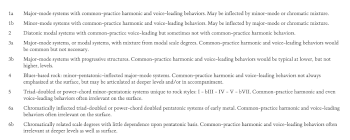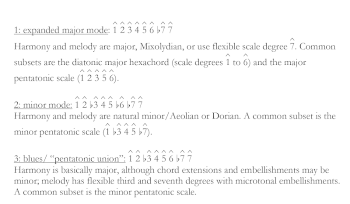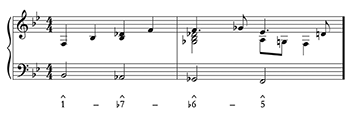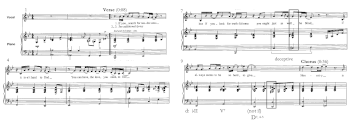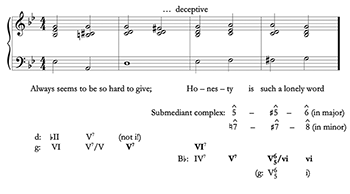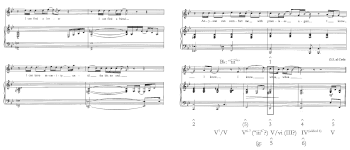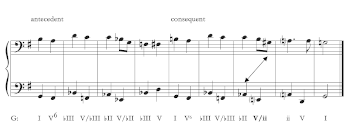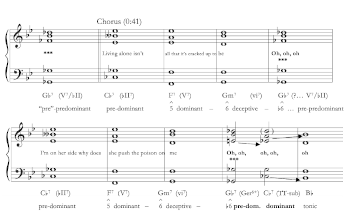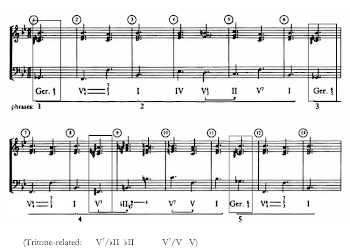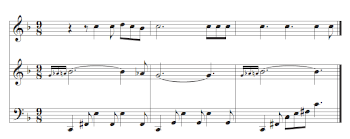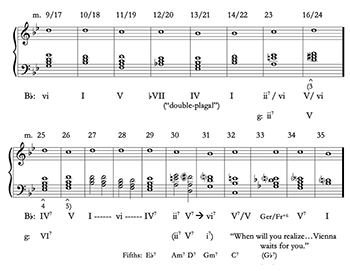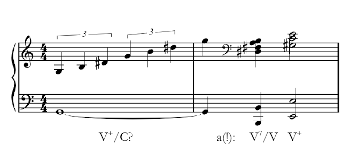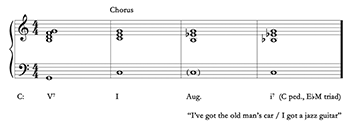Billy Joel’s Enharmonic Duplicity
Andrew Aziz
KEYWORDS: Billy Joel, enharmonicism, modal mixture, chromaticism, bass line, augmented triad
ABSTRACT: This article investigates Billy Joel’s chromatic excursions in his contemplative songs, many of which infuse modal mixture chromaticism against a prevailing major key backdrop. In particular, I spotlight Joel’s exploration of “enharmonic duplicity,” in which chromaticism reflects the complexity of human nature through enharmonic transformations. Part 1 explores enharmonicism in “Honesty,” the first of several analyzed
DOI: 10.30535/mto.28.2.1
Copyright © 2022 Society for Music Theory
Introduction
[0.1] In his 2017 book on Billy Joel, Joshua S. Duchan cites specific instances in which the Western classical canon greatly influenced Billy Joel’s output. Working backward from Joel’s “classical” album—Fantasies and Delusions (2001)—overt quotations of the canon notably appear in “This Night” (Beethoven’s Piano Sonata No. 8 in C minor, “Pathétique,” ii); more subtle references to the Romantic era appear in his “Nocturne” (Duchan 2017, 120)—a generic homage—as well as particular references to Chopin (Everett 2000).(1) To reflect the prevailing influence of common-practice procedures in Joel’s work, Everett proclaims that “most of (Joel’s) writing is closer to that of Brahms than it is to Howlin’ Wolf’s” (though not to imply that it is Brahmsian) and that much of rock music owes to the “same fundamental harmonic and voice-leading principles as those that govern the tonal structures of any prior style” (2004, [6]).(2) Considering the vast terrain of tonal conventions in rock, Joel’s application of common-practice procedures, especially his “unifying command of both diatonic and chromatic harmonic direction” (Everett 2000, 421), is ripe for further investigation.
Example 1. Classification of Rock’s Preeminent Tonal Systems (Everett 2004, Table 1)
(click to enlarge)
Example 2. Tonal Systems in Pop/Rock (reproduced from Biamonte 2017, Example 2)
(click to enlarge and see the rest)
[0.2] This article investigates Joel’s chromatic excursions in his contemplative songs, many of which infuse modal mixture chromaticism against a prevailing major key backdrop. Several previous surveys of chromaticism include Everett’s 1997 essay on Paul Simon’s output during the 1970s; more recent MTO contributions discuss chromatic semitonal voice-leading—Heetderks 2015 and Forrest 2017—within seventh-chord and triadic contexts, respectively.(3) Most of my observations fall within Type 1a or Types 3a/b of Everett 2004’s table of “preeminent tonal systems in rock,” shown in Example 1.
Nicole Biamonte has refocused the scope of such chromatic alterations, positing a new hierarchy based on recent research, eliminating Everett’s 3b category (2017, 92–94). Chromatic mixture in the common-practice sense is notably absent from Biamonte’s first four “tonal systems” categories (see Example 2), the first of which calls for an “expanded major mode” that allows for the flexibility of /
[0.3] I was first drawn to particular moments of modal mixture in preparation for a 2016 public musicology conference at Colorado College titled “It’s Still Rock and Roll to Me: The Music and Lyrics of Billy Joel.” Sean Atkinson presented a paper there (later published as Atkinson 2018) that explored how unexpected harmonic progressions may reflect a “marked” moment within the musical narrative.(5) Conceived separately from mine, Atkinson’s work discusses applications of
[0.4] When further considering Joel’s use of mixture, I discovered that it was not just deception that surfaced in several other songs, but in fact, a duplicity—one that is reflected not only in the text, but also through enharmonic chromaticism. For example, chromatic mixture
[0.5] A crucial difference between a common-practice score and rock transcriptions: in the absence of an archived score by the songwriter, chromatic pitch-class spellings are often surmised by their chordal resolutions. In nearly all cases, enharmonic spelling is made apparent by function as reflected in published or original transcriptions. A similar approach to transcription was taken by Reale (2014) in the “enharmonic seams” within Fiona Apple’s bi-tonal “Extraordinary Machine” with a conceptual difference: in Apple’s song, the enharmonic pitches were (usually) members of two separate diatonic collections. While Reale effectively applies nineteenth-century chromatic lenses, I will as often cue a listener’s “rock ears,” which should always remain vigilant. Nevertheless, beyond Joel’s obvious quotations and traceable influences to common-practice repertoire, I will—owing to Everett—spotlight “vestigial traits of classical composers through much of (Joel’s) output” (2000, 425), which grew out of Joel’s “general, ‘unconscious’ ear for harmony and counterpoint, which often seems based upon years of careful study of techniques of the common-practice canon but was in reality absorbed without much intention” (Everett 2000, 428).(10)
[0.6] Part 1 of this article explores enharmonicism in “Honesty,” the first of several
“Honesty,” Enharmonicism, and Mixture Bass Lines
[1.1] The functional ambiguity of chromatic mixture pitch classes manifests in Joel’s “Honesty,” featured on his 1978 album, 52nd Street. Many of the album’s selections espouse a “distinctively jazz flavor” (Duchan 2017, 9), though “Honesty,” by contrast, contains “hints of Chopin” (Everett 2000, 112), imbuing its rich linear chromaticism and reflective setting.
Example 3. “Honesty,” piano intro, mm. 1–2 (0:00–0:09)
(click to enlarge and listen)
[1.2] Though the bulk of the song situates in
Example 4. “Honesty,” mm. 1–11 (0:00–0:39)
(click to enlarge and listen)
[1.3] The first verse of “Honesty” comprises a parallel period (Example 4). Measures 3–6 form a four-bar antecedent; unlike the intro, the first phrase contains no evidence of chromatic mixture. The only chromatic pitch (
[1.4] This is, of course, not what happens. Once the A7 in m. 9 resolves to a D7 instead (possessing a 4-3 suspension), the resultant chord itself carries the potential for dominant function, pointing to an unrealized tonicization of the submediant Gm. This move is significant for two reasons. First, the elision has transformed the tonicization from one that is “cadential” to one that is “transitional,” generating energy gain for the new section (Clement 2019, 8); the D7 must resolve at the beginning of the next phrase, which is the chorus supporting the lyric “Honesty.” Secondly, the original
Example 5. Deceptive motion in “Honesty,” mm. 9–12 (0:29–0:42)
(click to enlarge and listen)
[1.5] Example 5 models our perception of the harmony during mm. 9–12, including a setting of the word “Honesty” with a deceptive progression to
Example 6. Harmonic “Epiphany” of vi
(click to enlarge)
[1.6] Even once the chorus subsequently finds permanence in
Example 7. “Honesty,” bridge, mm. 22–30 (2:05–2:36)
(click to enlarge and listen)
[1.7] Example 7 displays the bridge section in its entirety. At first, the bass line descends—à la the opening lament—until changing course at m. 26, a dominant-functioning chord possessing an accented neighbor D—a veiled “iii6.” This is, however, not the last triad with an apparent root of D in the bridge; m. 29 harmonizes a meekly declared “I know” with the same sonority as m. 26. From the perspective of bass scale degrees, however, this event in m. 29 is unsurprising: starting in m. 27, a linear progression unfolds a climbing – – – – , with the bass note after emulating a possible cadential arrival. Alas, the move to V/vi (or III) momentarily thwarts such an arrival with a flash of chromaticism; this progression—V to V/vi (or III)—is the very same one depicted by Atkinson as “Deceptive” in “She’s Always a Woman” (0:23). A crucial difference: in “She’s Always a Woman,” V/vi resolves to vi; whereas, in “Honesty,” the listener has come to expect the D–
[1.8] In summary, “Honesty” introduces mixture (flat-sided) scale degrees early on, only for their enharmonic (sharp-sided) equivalents to bloom over the course of the song. Though the song’s climax showcases the sharp-sided enharmonicism, the mixture degree leaves its lasting impression.
Example 8. Outer-voice reduction of verse-refrain of “Through the Long Night” (0:12–0:35)
(click to enlarge and listen)
[1.9] “Through the Long Night” exhibits an enharmonic journey in a similar manner as “Honesty.” The song supplies a source of discomfort: the narrator’s romantic partner has experienced a traumatic past (“The warm tears / The bad dreams / The soft trembling shoulders / The old fears”). The narrator, nevertheless, will support his partner through the night (“But I’m here / Through the long night with you / With you”). Example 8 displays an outer-voice reduction of the first antecedent-consequent pair (verse + refrain).
[1.10] The Roman numeral analysis reflects a bevy of back-relating dominant pairs, including tonicizations of mixture
Example 9. Bass line of bridge sections, “Through the Long Night” (1:07–1:30)
(click to enlarge and listen)
[1.11] The sharp-sided enharmonicism of “Through the Long Night” continues to bear fruit in the bridge sections (1:07–1:30; 1:53–2:16). As in “Honesty,” the refrain transitions into the bridge with an immediate tonicization of vi, employing a familiar technique: the submediant complex (1:07), serving as a vehicle for the initial
Example 10. Opening bass line, “Miami 2017” (2x, 0:17–0:29)
(click to enlarge and listen)
[1.12] Several other songs in Joel’s discography—projecting forlorn or pessimistic outlooks—also plant modal mixture’s dystopic seeds in their respective introductory bass lines. The main song that encapsulates Atkinson’s trope of “Denied Ending,” “Miami 2017” (Turnstiles, 1975), introduces the shade of modal mixture
Example 11. Opening bass line, “State of Grace” (0:00–0:18)
(click to enlarge and listen)
[1.13] An additional song, “State of Grace” (Storm Front, 1989), also projects a pessimistic outlook with its opening bass line (Example 11), serving as the main progression for each verse. Portraying a disintegration of the relationship with his then-wife Christie Brinkley, Joel’s text describes scenes in which their communications are unrequited:
There you go, slipping away into a state of grace;
I know the look that comes across your face; It’s so familiar to me.Here I am, trying to keep you in my line of sight;
I’m never certain you read me right; Sometimes you don’t want to see.
[1.14] While the lyrical narrative displays Joel’s contemplative tone throughout, timbre and harmony play a crucial role in establishing the religious underpinning asserted by the song’s title; Duchan agrees that such elements convey a sense of separation (2017, 89). Timbrally, the opening gambit establishes an organ foundation, personifying a state of spirituality (or, “grace” as articulated by the song’s lyrics); the piano’s open octaves in the upper register divert the music into the heavens. Harmonically, the myriad modal mixture chords, of course, underscore Joel’s pessimistic outlook. While the opening two bass notes/chords (I and V6) do not at first reveal any brewing undercurrent, the melodic augmented second leap from to
[1.15] The previous three songs all bear a particular similarity: Joel introduces mixture scale degrees early in a major-mode song, often in an opening bass line. Portending a distinct undertone of “proceed with caution,” the song may temporarily break free of its flatted scale degrees—even achieving stretches of optimism. Ultimately, however, the songs’ fates are sealed by their openings; major mode is always shadowed by chromaticism.
“Laura” and Functional Duplicity
[2.1] Everett describes “Laura”—from Nylon Curtain (1982), heavily invoking a Beatles sound—as the most “vicious of all of Joel’s songs” (2000, 436). Duchan asserts that the song expresses a man’s frustration with a woman who seems to have a strong emotional grip on him (2015, 173). While the love interest of Joel’s narrator in “She’s Always a Woman” is similarly sinister (“she’ll carelessly cut you, and laugh while you’re bleeding”), the songwriter qualifies her actions; she would always be in his good graces. In contrast, the grip of Laura is “far less enjoyable” (Duchan 2017, 104), with Everett describing Laura as an “aggressive woman who traumatizes the singer, vexing him at every turn” (2000, 433). In a Schenkerian sketch of this
Example 12. Opening bass line of “Laura,” introduction (2x, 0:00–0:13)
(click to enlarge and listen)
[2.2] As in “Honesty”, Joel supplies modal mixture in the song’s intro with a descending four-note bass line that immerses itself in mixture sonorities. The opening bars of “Laura” include the scale degrees ,
Example 13. Opening bass line of “Laura,” verse (0:14–0:27)
(click to enlarge and listen)
Example 14. Harmonic reduction of chorus, “Laura” (0:38–1:08)
(click to enlarge and listen)
[2.3] Despite the chromaticism of the introduction (also as in “Honesty”), the opening verse does not follow through, instead supplying the following four-chord harmonic formula in Example 13: Notably, the stepwise descending chromatic mixture of
[2.4] As the song ramps up for the intensified (potentially a “breakout”; see Doll 2011, [2]) chorus, the
G♭ 7 is always followed byC♭ 7. The first two instances adopt the default spelling of a major-minor seventh for their chordal sevenths (F♭ andB♭ ♭ , respectively).- Each of the first two
C♭ 7’s is followed by F7, echoing the tritone relationship between the preparatory C7 andG♭ 7. The thirdC♭ 7, however, goes directly back to tonic. - Each of the F7’s, presumably dominant in function, resolve deceptively to Gm7 chords (perhaps unsurprising given Joel’s tendency to resolve this way).
[2.5] The initial
[2.6] Ramping up from the second
[2.7] Backing up to the prior
Example 15. “Am Leuchtenden Sommermorgen” reduction in Agawu 1994, 92 (instances of enharmonic chord boxed)
(click to enlarge)
[2.8] A discussion of this functional/enharmonic duplicity would not be complete without citing a vestigial allusion to nineteenth-century techniques, in particular, Robert Schumann’s influential cycle Dichterliebe.(25) A chord enharmonic to the same “
The “Vienna” Chord Waits
Example 16. “Vienna,” piano intro (0:00–0:13)
(click to enlarge and listen)
[3.1] Measure 1 of “Vienna” (The Stranger, 1977) showcases a distinctive opening augmented triad
There is also a lot of inside stuff on the song. The beginning and the end is very Kurt Weill. That kind of sick, middle-European, kinky decadent thing. . . cabaret kinda. . . there’s a lot of crazy stuff going on. (Joel 1997)
An inspection of some of Weill’s songs reveals a possible source of “Vienna”’s characteristic opening motive—the triplet grace-note anacrusis, boxed in Example 16. A transposed augmentation of the motive also occurs in the pickup to m. 5.
Example 17. Source of triplet motive: Weill, “Come Up from the Fields, Father”
(click to enlargen)
[3.2] The source is Weill’s setting of four poems by Walt Whitman, who—like Joel—spent formative years in Long Island. The song containing the triplet motive is Weill’s “Come Up from the Fields, Father,” whereby a family comes to grips with a discouraging letter stating that their son at war has been maimed or killed in battle. The motive is introduced during a vocal utterance (“And the farm prospers well / Down in the fields all prospers well”), foreshadowing the onset of bad news (Example 17). The distinctive triplet embellishes a pernicious sound world: a sonority of C–E–
[3.3] Perhaps trying to inject some of Weill’s anxious mysticism into his own intro (and outro), Joel adopts this very sound world, even including the characteristic triplet grace note. In “Vienna,” the triplet begins with a
[3.4] A glance at the lyrics depicts a narrator declaring that a youthful subject should resist trailblazing at warp speed, and instead realize that a goal (signified by “Vienna”) is inevitable.
Slow down, you crazy child
You’re so ambitious for a juvenile
But then if you’re so smart, tell me
Why are you still so afraid, hmm?Where’s the fire, what’s the hurry about?
You’d better cool it off before you burn it out
You’ve got so much to do
And only so many hours in a day, ayyBut you know that when the truth is told
That you can get what you want or you can just get old
You’re gonna kick off before you even
Get halfway through, ooh
When will you realize, Vienna waits for you?
Example 18. Reduction of “Vienna,” piano intro
(click to enlarge)
As such, the chord signifies the youth’s frenzy to achieve, while the narrator quells the youth’s anxiety. I suggest that the unavoidable destination of Vienna is musically depicted through enharmonic chromaticism. As shown in Example 18, the augmented triad’s
[3.5] As mentioned above, the initial augmented triad, if functioning within a –
[3.6] The resulting sonority delivers two tritones,
[3.7] Between mm. 4 and 5, however, the
Example 19. Reduction of “Vienna” (0:14–0:30; 0:31–0:47; 0:47–1:07)
(click to enlarge and listen)
[3.8] Example 19 displays a reduction of the verse from “Vienna” that unfolds as a period structure: an eight-bar antecedent that concludes on V/g (mm. 9–16); a repetition of the antecedent that replaces C7 with Am7 in m. 23; and an eleven-bar consequent that, after several twists and turns, settles on the tonic of
[3.9] The consequent restores the enharmonically duplicitous
Example 20. Opening of “Zanzibar”
(click to enlarge and listen)
[3.10] The augmented triad as an agent of enharmonic duplicity appears in several other of Joel’s songs. The first such instance surfaces in the opening piano introduction of “Zanzibar” (52nd Street), a jazzy selection with plot lines involving the narrator, a waitress at a bar (Zanzibar), and baseball metaphors. The initial spelling of the G augmented triad’s
Example 21. “Zanzibar,” opening of chorus (0:55–1:01)
(click to enlarge and listen)
[3.11] In preparation for the chorus, “Zanzibar” turns from A minor to its relative C major, a typical “expressive” modulation in pop/rock music (Doll 2011). But this move is unsurprising, especially in light of our dominant augmented sonority from m. 1 that foreshadows the C major arrival. As seen in Example 21, a preparatory V7 resumes dominant function in C, carrying forward to a tonic chord, then back to the same enharmonically-equivalent augmented triad. Here, however, instead of a
[3.12] A final example in which the augmented triad participates in an enharmonic process occurs in “Where’s the Orchestra?”. As Duchan attests, like the overall mood of its album Nylon Curtain, “Where’s the Orchestra?” portrays “disappointment, frustration, and resignation,” as the song’s protagonist takes in a night of theater but is confounded by lack of musical accompaniment (2017, 53); the following opening lyrics embodies such angst:
Where’s the orchestra?
Wasn’t this supposed to be a musical?
Here I am, in the balcony,
How the hell could I have missed the overture?
Example 22. “Where’s the Orchestra,” introduction (0:00–0:12)
(click to enlarge and listen)
The piano introduction is sparked by an immediate flat-side key (
Example 23. “Where’s the Orchestra,” opening verse (0:13–0:49)
(click to enlarge, see the rest, and listen)
[3.13] In all, the sonority appears three times in the verse, supplied in Example 23. The narrator’s confusion persists throughout, manifesting through modal mixture (boxed) and augmented triads (circled). The semitonal shifts—mostly involving the pitch class
Conclusion
[4.1] In the preceding examples, Joel presents various harmonic contexts in which enharmonic chromaticism traces its own narrative along with the songs’ texts. Selections considered in this essay invite approaches that balance both nineteenth-century common-practice contexts in tandem with contemporary theories of rock harmony. While many of Joel’s songs possess evocative modal mixture for text setting purposes (“Lullaby,” “She’s Got a Way,” and “Just the Way You Are,” to name a few), enharmonic duplicity is somewhat rarer. Studying Joel’s discography, I was first struck that the more inscrutable chromatic ventures—often setting profoundly personal and introspective texts—take place in the key of flat-sided
[4.2] While each of the sections in this article explores novel processes that involve enharmonicism, the “duplicity” arises in similar ways. In nearly every case, a chromatic pitch appears in the song’s introduction, either a mixture scale degree or its enharmonic equivalent. Several times chromatic pitches are introduced in the form of a bass line, especially the ones that involve mixture. Once these chromatic pitches are introduced, however, the songs take very different paths. In Part 1, the opening bass line of “Honesty” introduces flat-sided mixture chromaticism, and the sharp-sided equivalents bloom by the onset of the chorus, and finally in the bridge; “Through the Long Night” introduces flat-sided chromaticism in its introduction and verses, and also transitions to the sharp side in the bridge. In Part 2, “Laura” exhibits a juxtaposition of perfect intervals versus tritones, and a functional re-contextualization of different sonorities that imply enharmonic interchange. Finally, in Part 3, “Vienna” establishes the augmented triad as an agent for duplicity; setting up both spellings in the introduction yields enharmonic dividends across the song. We also observe that the augmented triad provides the seeds for an enharmonic journey in “Zanzibar” and “Where’s the Orchestra?,” albeit in distinct textual environments. Altogether, the article reveals enharmonic relationships that amplify various identities portrayed by Joel’s complex stories of human nature.
Andrew Aziz
San Diego State University
5500 Campanile Drive
San Diego, CA 92182
aaziz@sdsu.edu
Works Cited
Agawu, Kofi. 1994. “Ambiguity in Tonal Music: A Preliminary Study.” In Theory, Analysis, and Meaning in Music, ed. Anthony Pople, 86–107. Cambridge University Press.
Anson-Cartwright, Mark. 1996. “Chord as Motive: The Augmented-Triad Matrix in Wagner’s ‘Siegfried Idyll.’” Music Analysis 15 (1): 57–71. https://doi.org/10.2307/854170.
Atkinson, Sean. 2018.“Deceptive Love and Denied Endings: Tropes in the Music of Billy Joel.” Popular Music 37 (3): 415–23. https://doi.org/10.1017/S0261143018000405.
Bailey, Robert. 1985. “An Analytical Study of the Sketches and Drafts. In Prelude and Transfiguration from “Tristan und Isolde,” ed. Robert Bailey, 113–46. W.W. Norton.
Bauer, Amy. 2011. Ligeti’s Laments: Nostalgia, Exoticism, and the Absolute. Ashgate.
Biamonte, Nicole. 2008. “Augmented Sixth Chords vs. Tritone Substitutions.” Music Theory Online 14 (2). https://doi.org/10.30535/mto.14.2.2.
—————. 2010. “Triadic Modal and Pentatonic Patterns in Rock Music.” Music Theory Spectrum 32 (2): 95–110. https://doi.org/10.1525/mts.2010.32.2.95.
—————. 2017. “Pop/Rock Tonalities.” In Tonality Since 1950, ed. Felix Wörner, Ullrich Scheideler, and Philip Rupprecht, 89–101. Fritz Steiner Verlag.
Bribitzer-Stull, Matthew. 2006. “The Ab–C–E Complex: The Origin and Function of Chromatic Major Third Collections in Nineteenth-Century Music.” Music Theory Spectrum 28 (2): 167–90. https://doi.org/10.1525/mts.2006.28.2.167.
Capuzzo, Guy. 2004. “Neo-Riemannian Theory and the Analysis of Pop-Rock Music.” Music Theory Spectrum 26 (2): 177–200. https://doi.org/10.1525/mts.2004.26.2.177.
—————. 2009. “Sectional Tonality and Sectional Centricity in Rock Music.” Music Theory Spectrum 31 (1): 157–74. https://doi.org/10.1525/mts.2009.31.1.157.
Clement, Brett. 2019. “Diatonic and Chromatic Tonicization in Rock Music.” Journal of Music Theory 63 (1): 1–34. https://doi.org/10.1215/00222909-7320450.
Cohn, Richard. 1999. “As Wonderful as Star Clusters: Instruments for Gazing at Tonality in Schubert.” 19th-Century Music 22 (3): 213–32. https://doi.org/10.2307/746799.
Cone, Edward T. 1982. “Schubert’s Promissory Note: An Exercise in Musical Hermeneutics.” 19th-Century Music 5 (3): 233–41. https://doi.org/10.2307/746462.
Doll, Christopher. 2011. “Rockin’ Out: Expressive Modulation in Verse-Chorus Form.” Music Theory Online 17 (3). https://doi.org/10.30535/mto.17.3.3.
—————. 2017. Hearing Harmony: Towards a Tonal Theory for the Rock Era. University of Michigan Press. https://doi.org/10.3998/mpub.3079295.
Duchan, Joshua S. 2015. “Disappointment, Frustration, and Resignation in Billy Joel’s ‘The Nylon Curtain.’” Rock Music Studies 2 (2): 168–87. https://doi.org/10.1080/19401159.2015.1022396.
—————. 2017. Billy Joel: America’s Piano Man. Rowman and Littlefield.
Everett, Walter. 1992. “Voice Leading and Harmony as Expressive Devices in the Early Music of the Beatles: ‘She Loves You.’” College Music Symposium 32: 19–37. https://www.jstor.org/stable/40374200.
—————. 1997. “Swallowed by a Song: Paul Simon’s Crisis of Chromaticism.” In Understanding Rock: Essays in Musical Analysis, eds. John Covach and Graeme M. Boone, 113–53. Oxford University Press.
—————. 2000. “The Learned vs. The Vernacular in the Songs of Billy Joel.” Contemporary Music Review 18 (4): 105–29. https://doi.org/10.1080/07494460000640051.
—————. 2004. “Making Sense of Rock’s Tonal Systems.” Music Theory Online 10 (4). https://www.mtosmt.org/issues/mto.04.10.4/mto.04.10.4.w_everett.html.
—————. 2008. “Pitch Down the Middle.” In Expression in Pop-Rock Music: Critical and Analytical Essays, ed. Walter Everett, 111–74. Routledge. https://doi.org/10.4324/9780203940044.
Forrest, David. 2017. “PL Voice Leading and the Uncanny in Pop Music.” Music Theory Online 23 (4). https://doi.org/10.30535/mto.23.4.6.
Harrison, Daniel. 1995. “Supplement to the Theory of Augmented-Sixth Chords.” Music Theory Spectrum 17 (2): 170–95. https://doi.org/10.2307/745870.
Heetderks, David. 2015. “Hipster Harmony: The Hybrid Syntax of Seventh Chords in Post-Millennial Rock.” Music Theory Online 21 (2). https://doi.org/10.30535/mto.21.2.5.
Joel, Billy. 1993. The Billy Joel Keyboard Book. Hal Leonard.
—————. 1996. “Q&A: Who Was Laura, and What Did She Do? (Lecture at Hobart & William Smith Colleges).” YouTube video, 5:09. Accessed July 10th, 2021. https://www.youtube.com/watch?v=i0SXDkWDeSM.
—————. 1997. The Complete Hits Collection: 1973–1997. Columbia Records.
—————. 2021. “Where’s the Orchestra?” Universal Music Publishing Group. Accessed July 2nd, 2021. https://www.musicnotes.com/sheet-music/artist/billy-joel.
Kaminsky, Peter. 1992. “The Popular Album as Song Cycle: Paul Simon’s ‘Still Crazy After All These Years.” College Music Symposium 32: 38–54. https://www.jstor.org/stable/40374201.
Klein, Michael. 2005. Intertextuality in Western Art Music. Indiana University Press.
Kowalke, Kim H. 2000. “‘I’m an American!’ Whitman, Weill, and Cultural Identity.” In Walt Whitman and Modern Music: War, Desire, and the Triads of Nationhood, ed. Lawrence Kramer, 109–31. Garland. https://doi.org/10.4324/9781315052885-6.
Laitz, Steven. 1996. “The Submediant Complex: Its Musical and Poetic Roles in Schubert’s Songs.” Theory and Practice 21: 123–65.
McCreless, Patrick. 1991. “Syntagmatics and Paradigmatics: Some Implications for the Analysis of Tonal Music.” Music Theory Spectrum 13 (2): 147–78. https://doi.org/10.2307/745896.
Muniz, John. 2019. “A Tendency-Transformational Model of Enharmonic Modulations and Related Phenomena.” Music Theory Spectrum 41 (1): 1–20. https://doi.org/10.1093/mts/mty027.
Nobile, Drew. 2020. “Double-Tonic Complexes in Rock Music.” Music Theory Spectrum 42 (2): 207–26. https://doi.org/10.1093/mts/mtaa003.
Osborn, Brad. 2017. “Rock Harmony Reconsidered: Tonal, Modal, and Contrapuntal Voice-Leading Systems in Radiohead.” Music Analysis 36 (1): 59–93. https://doi.org/10.1111/musa.12085.
Platt, Russell. 2017. “Gabriel Kahane’s Emo ‘Dichterliebe.’” New Yorker, March 9th. https://www.newyorker.com/culture/culture-desk/gabriel-kahanes-emo-dichterliebe.
Reale, Haley Beverburg. 2014. “Making the Most of an Enharmonic Seam: Pitch Respellings, Semitone Relationships, and Mode Mixture in Fiona Apple’s ‘Extraordinary Machine.’” Theory and Practice 39: 75–108.
Schachter, Carl. 1983. “Motive and Text in Four Schubert Songs.” In Aspects of Schenkerian Theory, ed. David Beach, 61–77. Yale University Press. https://doi.org/10.12987/9780300162660-004.
Shea, Nicholas. 2020. “Descending Bass Schemata and Negative Emotion in Western Song.” Empirical Musicology Review 14 (3–4): 167–81. https://doi.org/10.18061/emr.v14i3-4.6790.
Smith, Peter H. 2013. “Tonal Pairing and Monotonality in Instrumental Forms of Beethoven, Schubert, Schumann, and Brahms.” Music Theory Spectrum 35 (1): 77–102. https://doi.org/10.1525/mts.2013.35.1.77.
Spicer, Mark. 2008. “Large-Scale Strategy and Compositional Design in the Early Music of Genesis.” In Expression in Pop-Rock Music: Critical and Analytical Essays, ed. Walter Everett, 313–44. Routledge.
—————. 2017. “Fragile, Emergent, and Absent Tonics in Pop and Rock Songs.” Music Theory Online 23 (2). https://doi.org/10.30535/mto.23.2.2.
Tagg, Philip. 2014. Everyday Tonality II: Towards a Tonal Theory of What Most People Hear. Mass Media Music Scholars’ Press.
Temperley, David, Iris Ren, and Zhiyao Duan. 2017. “Mediant Mixture and ‘Blue Notes’ in Rock: An Exploratory Study.” Music Theory Online 23 (1). https://doi.org/10.30535/mto.23.1.7.
Todd, R. Larry. 1988. “‘The Unwelcome Guest’ Regaled: Franz Liszt and the Augmented Triad.” 19th-Century Music 12 (2): 93–115. https://doi.org/10.2307/746735.
Discography
Discography
Billy Joel. 1976. “Miami 2017 (Seen the Lights Go out on Broadway).” Turnstiles. Columbia (LP).
—————. 1977. “Vienna.” The Stranger. Columbia (LP).
—————. 1978. “Honesty.” 52nd Street. Columbia (LP).
—————. 1978. “Zanzibar.” 52nd Street. Columbia (LP).
—————. 1980. “Through the Long Night.” Glass Houses (LP). Columbia.
—————. 1982. “Laura.” Nylon Curtain. Columbia (LP).
—————. 1982. “Where’s the Orchestra?” Nylon Curtain. Columbia (LP).
—————. 1989. “State of Grace.” Storm Front. Columbia (LP).
Footnotes
1. In particular, Chopin’s E-minor Prelude (op. 28 no. 4), in “She’s Got A Way” (1971), and a collection of Chopin references in “Surprises” (1982); see Everett 2000, 425–26. His 2000 study on the “learned and the vernacular” in Billy Joel—investigating “James” and “Laura” in particular—is one of few music-theoretic articles to investigate Joel’s oeuvre. Everett (1992), on the Beatles’ “She Loves You,” highlights the modal mixture’s prevalence within structural pre-dominants (see, in particular, the sketches on p. 21).
Return to text
2. More generally, Everett asserts: “Not only are pitch relationships at the core of pop-rock music, but they share many of the procedures of harmony and counterpoint by which tonal goals are identified, pursued, and frustrated in tonal musics of other styles. For this reason, many of the analytical systems devised over the past few centuries for the study of common-practice classical music are also applicable to our subject” (2008, 111).
Return to text
3. Heetderks 2015 discusses post-millennial rock groups, including Dirty Projectors, My Bloody Valentine, Deerhunter, Grizzly Bear, and Radiohead; Forrest 2017 considers a variety of bands from the 1960s to the 1990s.
Return to text
4. Regarding all of her categories, Biamonte posits: “All of the systems just described represent points along a continuum rather than discrete categories, and could apply to entire songs or to sections within a song – or, less commonly, to passages within a formal section. Along this continuum, instances of modal mixture might fall in between major or minor and the blues, or between any of the first four categories and chromaticism, depending on whether particular scale-degree inflections are perceived as structural or embellishing pitches” (2017, 94). From this standpoint, she highlights the continuous fluidity of scale degree function and spelling, as inflections may appear within varying scopes and for unpredictable spans of time.
Return to text
5. One of Atkinson’s marked moments (2018, 419) in “She’s Always a Woman” is the chromatic turn from V to III (V/vi). According to Everett (2004, [7]), this move falls “within the classical common practice at which he worked so hard as a young piano student composing in the styles of Beethoven and Chopin.”
Return to text
6. The
Return to text
7. Doll categorizes the pattern of –
Return to text
8. In McCreless’ 1991 article on the implications of chromaticism in tonal music, he defines two axioms: “The first, paradigmatics with respect to the system, emphasizes the importance of interpreting any chromatic event in terms not only of its syntagmatic linear or harmonic context, but also of the paradigmatic space that underlies it. The second, paradigmatics with respect to the piece, proposes for tonal music, particularly that of the late eighteenth century and the nineteenth century, a level of paradigmatic organization that invokes not just the abstract tonal space itself, but the motivic or associative use of that space within individual works” (160). Further explication of his system in terms of the Moment musical no. 6 is found on p. 166.
Return to text
9. This mode of analysis is similar to that of Schachter 1983.
Return to text
10. Michael Klein makes a similar distinction between the quotation and the vestigial, whereby vestigial is akin to “intertextuality,” with a direct allusion serving as a narrower subtype dubbed “influence”: “Following the implication of the distinction, any crossing of texts is an instance of intertextuality, any form of agency in which an author borrows from or alludes to another text is a more narrow instance of intertextuality called ‘influence’” (Klein 2005, 11–12).
Return to text
11. Doll characterizes this bass line as a “walking” bass line (Doll 2017, 122–23).
Return to text
12. According to Amy Bauer: “This traumatic kernel impels its iteration in multiple forms: from voice to instrument, soprano to bass, and private to public works. Thus its initial transformation from physical moan to musical topic parallels the promiscuous dissemination of the musical sigh across instrumental and genre boundaries, as well as its absorption into mechanical techniques such as canonic imitation and the passacaglia bass-line” (2011, 59).
Return to text
13. Nicholas Shea’s 2020 study on descending bass lines throughout common practice and popular music investigates association with negative emotion, in conjunction with tempo and articulation.
Return to text
14. Injecting Doll’s syntactic language, the
Return to text
15. By this point, the pitch classes
Return to text
16. An anonymous reviewer has suggested that the proposed V7 – VI7 can also be read as III7 – IV7. As the progression connects two phrases/sections—and not internal as III – IV tends to be, I lean toward V7 – VI7, syntactically; but the meaning of the progression, given the song’s lyrics and context, supplies strong support for the deceptive interpretation here. A different reviewer—with whom I agree—suggested that the mm. 11–12 deceptive exit is similar to that in “She’s Got A Way,” which follows its V –
Return to text
17. Peter Smith (2013) has explored tonal pairing in nineteenth-century instrumental compositions (Beethoven, Schubert, Schumann, and Brahms); Drew Nobile (2020) unpacks, in rock music, the coexistence of two keys at the same time (“double-tonic complex”). The concepts of “directional tonality” and “double-tonic complex” originate in Robert Bailey’s work on Wagner, particularly on Tristan und Isolde (1985). According to Smith, Bailey hears these two concepts “operating in conjunction with the heightened emphasis on modal mixture and semitonal voice-leading characteristic of nineteenth-century music” (2013, 79).
Return to text
18. For additional exploration of “sigh motive,” see Bauer 2011, 59–60.
Return to text
19. “The song’s stark opening, given in Example 9, reminds one of Brahms’s, Schenker’s, and Mast’s discussions of parallel fifths in Schubert’s ‘Die böse Farbe’” (Everett 2000, 437).
Return to text
20. In Joel’s 1996 lecture on “Laura,” he plays an
Return to text
21. One exception: Doll prefers “temporary” resolution to “deceptive” resolution (2017, 80), on account of its lack of deception after having heard the song numerous times. I maintain usage of deceptive for consistency across the article.
Return to text
22. Similar harmonic ambiguity is found in “Because” by The Beatles: an opening progression of i - iiø7 – V – VI – i – Ger+6 or V7/
Return to text
23. The 1996 lecture: https://www.youtube.com/watch?v=i0SXDkWDeSM; the 2006 concert: https://www.youtube.com/watch?v=AVkciI10qQs; and the 2014 concert https://www.youtube.com/watch?v=HfeVRziDkoI.
Return to text
24.
Return to text
25. Peter Kaminsky (1992) draws comparisons between song cycles—Dichterliebe in particular—and Paul Simon’s album “Still Crazy After All These Years”; Mark Spicer notes he notes how in Genesis’ song “Lover’s Leap,” there is a notable reminiscence to the Dichterliebe cycle, particularly in its harmonic ambiguity; he also notes that modal mixture is prominently featured (2008, 322); more recently, singer-songwriter Gabriel Kahane recorded Dichterliebe (self-accompanied), in which he styles the cycle as folk or art-pop (Platt 2017).
Return to text
26. Joel discusses Weill's influence at 8:09: https://www.youtube.com/watch?v=sWRiiH2MJ2U&t=489.
Return to text
27. A more idiomatic instance of an augmented triad supported by appears in Lesley Gore’s “It’s My Party”; the augmented triad supports a contrapuntally-derived
Return to text
28. Matthew Bribitzer-Stull offers that such an augmented triad is “not anchored by a diatonic Stufe, its symmetry can threaten tonality altogether (2006, 177). The early onset of this chord recalls Liszt’s mature style, as augmented triads appear ubiquitously amongst his settings of Petrarch Sonnet No. 104, “Pace non trovo,” in a variety of ways (Todd 1988, 980). They appear, perhaps, most famously, in his “Faust” symphony—headlining the entire work—as well as in the late, pedagogically-renowned Nuages Gris (which, too, shines a spotlight on the liberated
Return to text
29. Altogether, the scale degree progression is a stretched-out version of Doll’s “teasing” schema.
Return to text
30. Biamonte’s discussion of double-plagal progressions (2010, 98–101) primarily considers circular progressions; Doll (2017, especially 96–100) discusses them as loops or cadential gestures.
Return to text
31. “52nd Street bears a distinctively jazz flavor, not only in the midtown Manhattan reference in its name, but also in the contributions of jazz trumpeter Freddie Hubbard to ‘Zanzibar’” (Duchan 2017, 9).
Return to text
Copyright Statement
Copyright © 2022 by the Society for Music Theory. All rights reserved.
[1] Copyrights for individual items published in Music Theory Online (MTO) are held by their authors. Items appearing in MTO may be saved and stored in electronic or paper form, and may be shared among individuals for purposes of scholarly research or discussion, but may not be republished in any form, electronic or print, without prior, written permission from the author(s), and advance notification of the editors of MTO.
[2] Any redistributed form of items published in MTO must include the following information in a form appropriate to the medium in which the items are to appear:
This item appeared in Music Theory Online in [VOLUME #, ISSUE #] on [DAY/MONTH/YEAR]. It was authored by [FULL NAME, EMAIL ADDRESS], with whose written permission it is reprinted here.
[3] Libraries may archive issues of MTO in electronic or paper form for public access so long as each issue is stored in its entirety, and no access fee is charged. Exceptions to these requirements must be approved in writing by the editors of MTO, who will act in accordance with the decisions of the Society for Music Theory.
This document and all portions thereof are protected by U.S. and international copyright laws. Material contained herein may be copied and/or distributed for research purposes only.
Prepared by Michael McClimon, Senior Editorial Assistant
Number of visits:
11816
